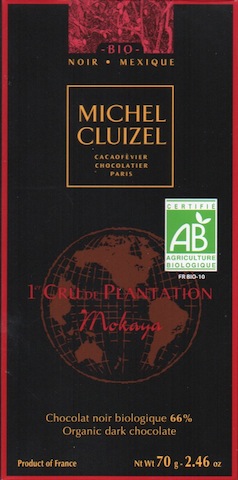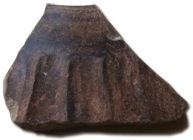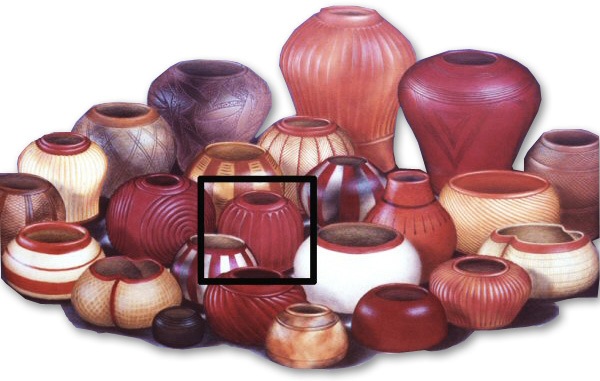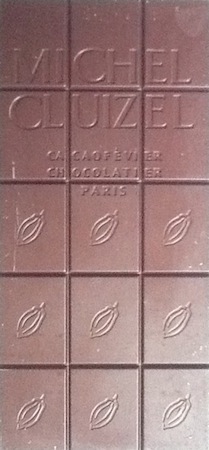
Impact
Mokaya.
Just the age-old sound of it carries a certain weight... in metric tonnage.
Ever the ethno-botanists of the chocolate universe, the French in general & Cluizel in particular conduct their due diligence. Evidently they've been doing their homework & studied The Concise History of Chocolate.
In addition to the name of the estate from which Cluizel sources the cacáo in this bar, Mokaya also honors the ancient people who were among the original cultivators of it.
The Mokaya (meaning “People of the Corn” ironically) flourished some 4000 years ago during the Barra Ceramic Phase at Paso de la Amada, Xoconochco (present day Soconusco), Pacific Coast of Chiapas, Mexico.
They produced a pottery distinguished by thin-walled, finely finished & elaborately decorated vessels.
 In 2008, one of 16 antique sherds investigated for cacáo-use tested positive for theobromine (a key marker for chocolate). Traces of it are found inside a Bayo Brown slipped tecomate with vertical fluting on its exterior surface, unearthed atop Structure 4 in Mound 6 — referred to as the “Chief’s House”.
In 2008, one of 16 antique sherds investigated for cacáo-use tested positive for theobromine (a key marker for chocolate). Traces of it are found inside a Bayo Brown slipped tecomate with vertical fluting on its exterior surface, unearthed atop Structure 4 in Mound 6 — referred to as the “Chief’s House”.
Taken as a whole complex, Mound 6 & its ascending structures represent a time-lapse microcosm of a shift from simpler egalitarian agriculture to stratified centralized power. Little can be gleaned however about the details behind cacáo’s usage then but this find raises questions, both functional (was it a chicha [alcoholic chocolate]? atole [chocolate / maize draft]? &/or possibly a balsamic-like condiment?) & social (how pervasive was cacáo in the community? restricted to elites? or pre-chiefdom & for everyone?)
In so calling this bar Mokaya, Cluizel respectfully recalls the past while seeking to revive it for the future.

Mokaya tecomatl & xicalli vessels from Paso de la Amada (drawing by Ajax Moreno); Upper Left: actual ceramic shard from the vessel (inset bordered in black) which tested positive for trace cacáo on its interior surface. Vessels eventually became ‘social currency’ among Mesoamericans, exchanged at feasts & ceremonial visits, preserved as heirlooms & funerary companions in the afterlife.
Just the age-old sound of it carries a certain weight... in metric tonnage.
Ever the ethno-botanists of the chocolate universe, the French in general & Cluizel in particular conduct their due diligence. Evidently they've been doing their homework & studied The Concise History of Chocolate.
In addition to the name of the estate from which Cluizel sources the cacáo in this bar, Mokaya also honors the ancient people who were among the original cultivators of it.
The Mokaya (meaning “People of the Corn” ironically) flourished some 4000 years ago during the Barra Ceramic Phase at Paso de la Amada, Xoconochco (present day Soconusco), Pacific Coast of Chiapas, Mexico.
They produced a pottery distinguished by thin-walled, finely finished & elaborately decorated vessels.
 In 2008, one of 16 antique sherds investigated for cacáo-use tested positive for theobromine (a key marker for chocolate). Traces of it are found inside a Bayo Brown slipped tecomate with vertical fluting on its exterior surface, unearthed atop Structure 4 in Mound 6 — referred to as the “Chief’s House”.
In 2008, one of 16 antique sherds investigated for cacáo-use tested positive for theobromine (a key marker for chocolate). Traces of it are found inside a Bayo Brown slipped tecomate with vertical fluting on its exterior surface, unearthed atop Structure 4 in Mound 6 — referred to as the “Chief’s House”.Taken as a whole complex, Mound 6 & its ascending structures represent a time-lapse microcosm of a shift from simpler egalitarian agriculture to stratified centralized power. Little can be gleaned however about the details behind cacáo’s usage then but this find raises questions, both functional (was it a chicha [alcoholic chocolate]? atole [chocolate / maize draft]? &/or possibly a balsamic-like condiment?) & social (how pervasive was cacáo in the community? restricted to elites? or pre-chiefdom & for everyone?)
In so calling this bar Mokaya, Cluizel respectfully recalls the past while seeking to revive it for the future.

Appearance 4.5 / 5


| Color: | regular medium brown with a sepia blush |
| Surface: | fit for a stained-glass window in the Church of Chocolate (cacáo, of course, sacramental in ancient Mesoamerica) |
| Temper: | recessed |
| Snap: | on the brittle side but good break-wall integrity |
Aroma 7.7 / 10
the original Model-T... of chocolate -- Tar, Tobacco & Tea (especially asphalt tar 'n nicotine) -- honked up with overhanging fruit (cloying cherry cordial with a cream tone; Cluizel always color-coordinates its bars, hence the red frame on the packaging? -- click image upper right to enlarge) above roasted cocoa
Mouthfeel 13.2 / 15
| Texture: | powder keg turns to the plush life |
| Melt: | relaxed as a 'flâneur' (French for stroll) |
Flavor 44.1 / 50
plain cocoa -> piloncillo (Mexican raw solid cane) creates a flash red sugar-plum -> musky citrus of tagete marigold -> spices in some vanilla + mecaxochitl (Piper sanctum a k a hoja santa [sacred leaf] a k a root beer plant... a heady complex of eucalyptus, licorice, sassafras, anise, nutmeg, mint, tarragon & black pepper; used to top off chocolate drinks in Mexico) -> browns up the earlier sugar burst into... well, brown sugar -> galvanizes all these warm brown notes into dried figs + the sweeter date-like variety of tamarind -> caramel vein lined in limestone (oddly good) -> flirts over a demi-tasse of café-cum-Mayan breadnut before it blows off cocoa dust
Quality 17.8 / 20
The 1st Premier Cru release from Cluizel in quite awhile. True to form, Cluizel resides mainly in the Semi-Dark ranges, rarely leaving the 60% territory.
Despite all the legacy surrounding the Mokaya & the environs, this hardly tastes origin-specific; in truth rather generic in character -- cocoa in / cocoa out. A sad state of affairs for a region once hailed as the home to, arguably, the greatest of all cacáo in antiquity.
Simple... borders boredom... yet simply excellent too. What it lacks in complexity it compensates for in subtlety & suppleness.
As always with Cluizel, a very deliberate chocolate that commands due consideration. Calibrated with precision; even the vanilla, a no-no among the neo-cocoa Spartans, so judiciously finessed here. Though it colors the flavor, especially the end stages, it never mucks up the works.
Next to confrère Stéphane Bonnat's Xoconuzco, this feels more manipulated (vanilla & greater sugar ensure as much); his bears a more localized presence or sense of terroir. Both however reveal a cacáo of relatively Naked means (re: high CQ or Chocolate Quotient of baseline cocoa)... pure chocolate flavor free of, for the most part, interference or nuance.
Either way, the legend lives on.
INGREDIENTS: cocoa mass, sugar, cocoa butter, vanilla; CBS (Cocoa mass / Butter / Sugar ratio): ~ 5:8:7
Reviewed December 7, 2012
Despite all the legacy surrounding the Mokaya & the environs, this hardly tastes origin-specific; in truth rather generic in character -- cocoa in / cocoa out. A sad state of affairs for a region once hailed as the home to, arguably, the greatest of all cacáo in antiquity.
Simple... borders boredom... yet simply excellent too. What it lacks in complexity it compensates for in subtlety & suppleness.
As always with Cluizel, a very deliberate chocolate that commands due consideration. Calibrated with precision; even the vanilla, a no-no among the neo-cocoa Spartans, so judiciously finessed here. Though it colors the flavor, especially the end stages, it never mucks up the works.
Next to confrère Stéphane Bonnat's Xoconuzco, this feels more manipulated (vanilla & greater sugar ensure as much); his bears a more localized presence or sense of terroir. Both however reveal a cacáo of relatively Naked means (re: high CQ or Chocolate Quotient of baseline cocoa)... pure chocolate flavor free of, for the most part, interference or nuance.
Either way, the legend lives on.
INGREDIENTS: cocoa mass, sugar, cocoa butter, vanilla; CBS (Cocoa mass / Butter / Sugar ratio): ~ 5:8:7
Reviewed December 7, 2012




